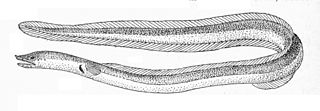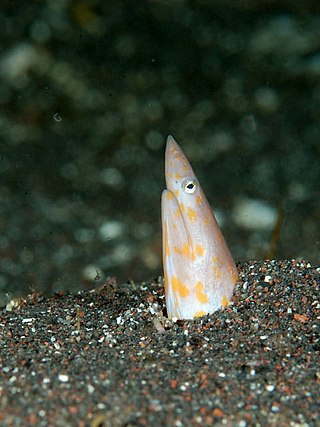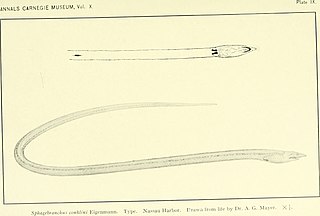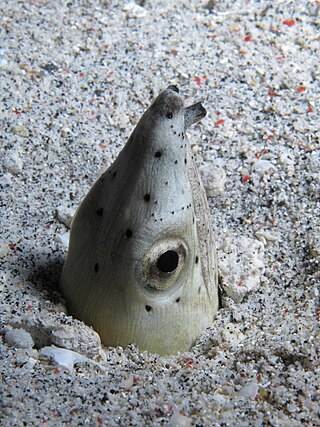Echidna leucotaenia, the whiteface moray, also known as the white-banded moray eel, is a moray eel. It was described by Schultz in 1943. It is a tropical, marine and freshwater eel which is known from the Indo-Pacific, including East Africa, the Line Islands, the Tuamotu Islands, and Johnston Island. It dwells at a depth range of 0 to 24 metres, and leads a benthic lifestyle in reefs. Males can reach a maximum total length of 75 centimetres (30 in).
Cirricaecula is a genus of eels in the snake eel family Ophichthidae.
The black-nostril false moray, blacknose false moray or blacknose reef eel, is an eel in the family Chlopsidae. It was described by Leonard Peter Schultz in 1953. It is a tropical, marine eel which is known from throughout the Indo-Pacific, including the Chagos Islands, Samoa, the Ryukyu Islands, the southern Great Barrier Reef, and Micronesia. It typically dwells in coral reefs at depths greater than 14 m. They can reach a maximum total length of 12 cm (4.7 in).
The shortfin false moray is an eel in the family Chlopsidae. It was described by Leonard Peter Schultz in 1953. It is a tropical, marine eel which is known from American Samoa, Samoa, Australia, Fiji, French Polynesia, Indonesia, the Marshall Islands, New Caledonia, Palau, Papua New Guinea, the Solomon Islands, and Wallis and Futuna. It typically dwells in seaward and lagoon coral reefs at an approximate depth of 43 m. Males can reach a maximum total length of 13 centimetres (5.1 in).
The common false moray, false moray, grey reef eel, or plain false moray,, is an eel in the family Chlopsidae. It was described by Leonard Peter Schultz in 1943. It is a tropical, marine eel which is known from seaward reefs in the Indo-Pacific regions. It typically dwells at a depth around 56 metres (184 ft). Males can reach a maximum total length of 30 centimetres (12 in).
Penn's thrush eel is an eel in the family Moringuidae. It was described by Leonard Peter Schultz in 1953. It is a tropical, marine eel which is known from Papua New Guinea, in the western central Pacific Ocean.
The Maimed snake eel is an eel in the family Ophichthidae. It was described by Pieter Bleeker in 1857. It is a marine, tropical eel which is known from the Indo-Pacific, including the Red Sea, East Africa, Samoa, the Ryukyu Islands, Australia, and Micronesia. It dwells at a depth range of 1 to 13 metres, and inhabits coral reefs and lagoons, where it forms burrows in soft benthic sediments. Males can reach a maximum total length of 24 centimetres (9.4 in), but more commonly reach a TL of 8 centimetres (3.1 in).

The ordinary snake eel is an eel in the family Ophichthidae. It was described by Pieter Bleeker in 1864, originally under the genus Echelus. It is a marine, tropical eel which is known from the Indo-Western Pacific, including Vietnam, Japan, Fiji, the Marshall Islands, and Australia. It inhabits sandy sediments. Males can reach a maximum total length of 39 centimetres.
The Johnston snake eel, also known as the peppered worm eel in Micronesia and Hawaii is an eel in the family Ophichthidae. It was described by Leonard Peter Schultz and Loren Paul Woods in 1949. It is a marine, tropical eel, which is known from the Indo-Pacific region, including the Chagos Islands, Hawaii, the Marquesan Islands, the Society Islands, Australia, and New Caledonia. It dwells at a depth range of 2–23 m, and inhabits sand sediments in coral reefs. It can reach a maximum total length of 35 cm.
The Fringe-lipped worm-eel is an eel in the family Ophichthidae. It was described by Henry Weed Fowler in 1934. It is a marine, tropical eel which is known from the western central Pacific Ocean, including Taratara Island, Samar Island, the Philippines, the Marshall Islands, Micronesia and Solomon Island. It dwells at a maximum depth of 48 metres (157 ft), and inhabits benthic sand sediments in coral reefs. Males can reach a maximum total length of 11.5 centimetres (4.5 in).

The sharpsnout snake eel is an eel in the family Ophichthidae. It was described by Max Carl Wilhelm Weber in 1913. It is a marine, tropical eel which is known from the Indo-Western Pacific, including East Africa, the Marshall Islands, and the Hawaiian Islands. It dwells at a depth range of 10 to 25 metres, and lives in congregations in confined regions of sand sediments. Males can reach a maximum total length of 40 centimetres (16 in).

Callechelys lutea, the freckled snake eel or yellow-spotted snake eel, is an eel in the family Ophichthidae. It was described by John Otterbein Snyder in 1904.
Cirricaecula macdowelli is an eel in the family Ophichthidae. It was described by John E. McCosker and John Ernest Randall in 1993. It is a subtropical, marine eel which is known from Taiwan, in the northwestern Pacific Ocean. Males can reach a maximum total length of 22.8 centimetres.

The Surf eel is an eel in the family Ophichthidae. It was described by Barton Warren Evermann and Millard Caleb Marsh in 1900, originally under the genus Sphagebranchus. It is a marine, tropical eel which is known from the western and eastern Atlantic Ocean, including Bermuda, the Bahamas, Florida, USA; Puerto Rico, the Virgin Islands, northern South America, and St. Helena Island. It dwells at a maximum depth of 35 metres (115 ft), most often between 5 to 15 metres, and forms burrows in sand bottoms in surf areas, from which its common name is derived. Males can reach a maximum total length of 45 centimetres (18 in).
The Vulture sand eel is an eel in the family Ophichthidae. It was described by Max Carl Wilhelm Weber and Lieven Ferdinand de Beaufort in 1916, originally under the genus Sphagebranchus. It is a marine, tropical eel which is known from the Indo-Pacific, including Mascarenes, Pitcairn, Japan, Australia, Micronesia, and Easter Island. It dwells in inshore waters at a depth range of 2 to 18 metres, and forms burrows in soft, sandy sediments.

The highfin snake eel (Ophichthus altipennis, also known as the blackfin snake eel or the black-finned snake eel, is an eel in the family Ophichthidae. It was described by Johann Jakob Kaup in 1856, originally under the genus Microdonophis. It is a marine, tropical eel known from the eastern Indian Ocean and northwestern and western central Pacific Ocean, including Australia, French Polynesia, Indonesia, Japan, the Marshall Islands, Malaysia, the Philippines, and Papua New Guinea. It dwells at a depth range of 0 to 40 m, and forms burrows in soft inshore sand sediments. Males can reach a maximum total length of 103 cm.

The dark-shouldered snake eel is an eel in the family Ophichthidae. It was described by Pieter Bleeker in 1864. It is a tropical, marine eel which is known from the Pacific Ocean, including the East Indies, the Society Islands, the Mariana Islands, Queensland, the Marshall Islands, Micronesia, Japan, and India. It dwells at a depth range of 2–15 metres, and inhabits reefs. It forms burrows in mud and sand, and forages during the night. Males can reach a maximum total length of 115 centimetres.

The Evermann's snake eel is an eel in the family Ophichthidae. It was described by David Starr Jordan and Robert Earl Richardson in 1908. It is a marine, tropical eel which is known from the western Pacific Ocean. It inhabits inshore soft bottoms.
The Short-maned sand-eel is an eel in the family Ophichthidae. It was described by Geoffrey Palmer in 1970. It is a marine, tropical eel which is known from the Indo-Pacific, including the Red Sea, the Aldabra Islands, the Hawaiian Islands, and the Marquesan Islands. It is known to dwell at a depth of 60 metres (200 ft), and leads a benthic lifestyle. Males can reach a maximum total length of 59 centimetres (23 in).

The Marble-toothed snake-eel is an eel in the family Ophichthidae. It was described by Charles Henry Gilbert in 1898. It is a marine, tropical eel which is known from the eastern central and southeastern Pacific Ocean, including Costa Rica, Colombia, Panama and Ecuador. It dwells in shallow waters at a maximum depth of 10 metres (33 ft), and inhabits sand and mud sediments and mangroves. Males can reach a maximum total length of 68 centimetres (27 in).







